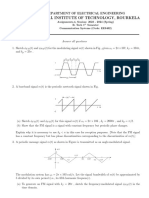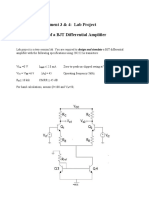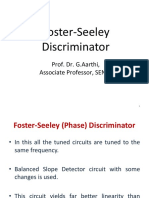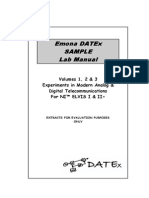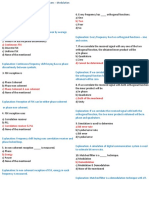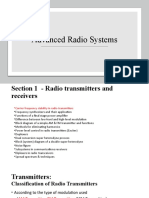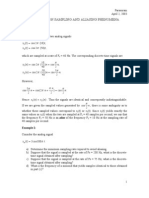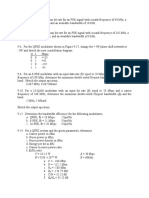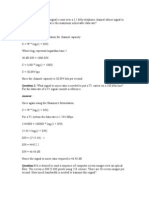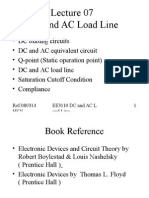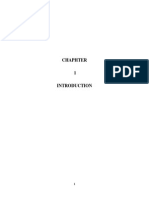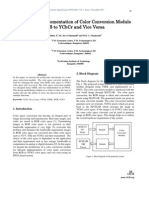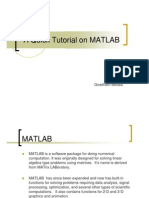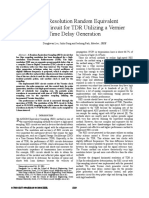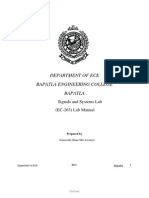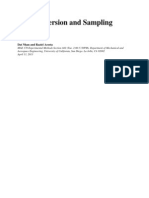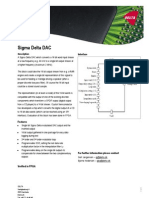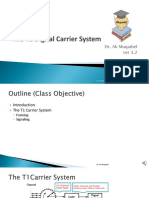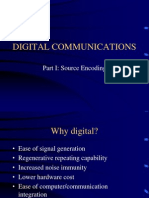EKT 343 Principle of Communication Engineering
Tutorial 5
1. Contrast the advantages and disadvantages of digital transmission.
The primary advantage of digital transmission over analog transmission is noise immunity. Digital
signals are inherently less susceptible than analog signals to interference caused by noise because
it is not necessary to evaluate the precise amplitude, frequency, or phase to ascertain its logic
condition.
Disadvantage:
The transmission of digitally encoded analog signals requires significantly more bandwidth than
simply transmitting the original analog signal.
2. Explain the relationship between dynamic range, resolution, and the number of bits in a PCM
code.
The relationship between dynamic range and the number of bits on a PCM code is
2^n - 1 > or = DR
And for a minimum number of bits 2^n = DR + 1
Where n = number of bits in a PCM code, excluding the sign bit
DR = absolute value of dynamic range
Dynamic range is inversely proportional to resolution
3. Determine the minimum number of bits required for PCM codes with the following dynamic
ranges and determine the coding efficiencies:
a) 24 dB
b) 48 dB
c) 72 dB
DR (dB ) = 20 log(2 n 1)
24 / 20 = log(2 n 1)
2 n = 15.85 + 1
log 16.85
n= = 4.07
log 2
n 4.07, n = 5
4.07
efficiency = x100% = 81.5%
5
IBA 2011/2012
�EKT 343 Principle of Communication Engineering
DR (dB ) = 20 log(2 n 1)
48 / 20 = log(2 n 1)
2 n = 251.19 + 1
log 252.19
n= = 7.98
log 2
n 7.98, n = 8
7.98
efficiency = x100% = 99.73%
8
DR (dB ) = 20 log(2 n 1)
72 / 20 = log(2 n 1)
2 n = 3981.07 + 1
log 3982.07
n= = 11.96
log 2
n 11.96, n = 12
11.96
efficiency = x100% = 99.66%
12
4. For a PCM system with the following parameters:
Maximum analog input frequency = 4 kHz
Maximum decoded voltage at the receiver= 2.55 V
Minimum dynamic range=46 dB
Determine
(a) Minimum sample rate
(b) Minimum number of bits used in the PCM code
(c) Resolution
(d) Quantization error
(e) Coding efficiency
(a) Nyquist rate, fs= 2B = 2(4 kHz) = 8 kHz
(b)
DR (dB ) = 20 log(2 n 1)
46 / 20 = log(2 n 1)
2 n = 199.53 + 1
log 200.53
n= = 7.64
log 2
n 7.64, n = 8
IBA 2011/2012
�EKT 343 Principle of Communication Engineering
8 bits must be used for the magnitude but one additional sign bit is required to indicate +ve and
ve voltage, thus the minimum number of bits=9
Vmax V 2.55
(c) resolution = = nmax = 8 = 0.01V
DR 2 1 2 1
resolution 0.01
(d) Qe = = = 0.005V
2 2
(e) Coding efficiency = minimum number of bits(including sign bit) x 100%
Actual number of bits(including sign bit)
= 8.64/9 x 100% =96%
5. Briefly explain the process of digital companding.
With digital companding, the analog signal is first sampled and converted to a linear PCM code
and then the linear code is digitally compressed. In the receiver, the compressed PCM code is
expanded and then decoded (i.e., converted back to analog).
6. Determine the voltage of the input signals if the SQR = 40 dB and q =0.2 V.
� �
�
�
10��� �
� � 40��
�
�
12�
� �
� 10000
�
12
� 5.77 �
7. A companding system with = 100 used to compand from 0V to 10 V sinusoid signal. Draw the
characteristic of the typical system.
Vmax ln(1 + (Vin Vmax ))
Vout =
ln(1 + )
IBA 2011/2012
�EKT 343 Principle of Communication Engineering
Vin 0 1 2 3 4 5 6 7 8 9 10
Vout 0 5.2 6.57 7.44 8.05 8.52 8.91 9.24 9.52 9.77 10
12
10
6 Vin
Vout
4
0
1 2 3 4 5 6 7 8 9 10 11
8. Suppose analog signal has the bandwidth of 15 kHz (uniform). Find the minimum first null
bandwidth (square wave pulses) at which it would be possible to transmit a PCM signal while
maintaining average SNR of at least 58 dB. Assume Vpeak = 5V.
IBA 2011/2012
�EKT 343 Principle of Communication Engineering
9. Consider a compact disc that uses pulse-code modulation to record audio signals whose
bandwidth 15 kHz. Specifications of the modulator include the following:
Quantization : uniform with 512 levels
Encoding: Binary
Determine:
(a) The Nyquist rate
(b) Minimum permissible bit rate
Nyquist rate, fs= 2B = 2(15 kHz) = 30 kHz
R = nfs
n = log 512/ log 2 =9
R = nfs= 9 (30kHz) = 270 kbits/s
10. A television signal (video and audio) has a bandwidth of 4.2MHz. This signal is sampled,
quantized and binary coded to obtain a PCM signal.
(a) Determine the sampling rate if the signal is to be sampled at a rate 20% above the Nyquist
rate.
(b) If the samples are quantized into 1024 levels, determine the number of binary pulses
required to encode each sample.
(c) Determine the binary pulses rate(bits per second) of the binary-coded signal, and the
minimum bandwidth required to transmit this signal
Nyquist rate, fs= 2B = 2(4.2 MHz) = 8.4 MHz
20% above Nyquist rate,fs = 120/100 x 8.4 MHz = 10.08 MHz.
2n=1024
n = log21024 = 10
R = nfs= 10(10.08MHz) = 100.8Mbits/s
Bmin = R/2 = 100.8 MHz/ 2 = 50.4 MHz
IBA 2011/2012












